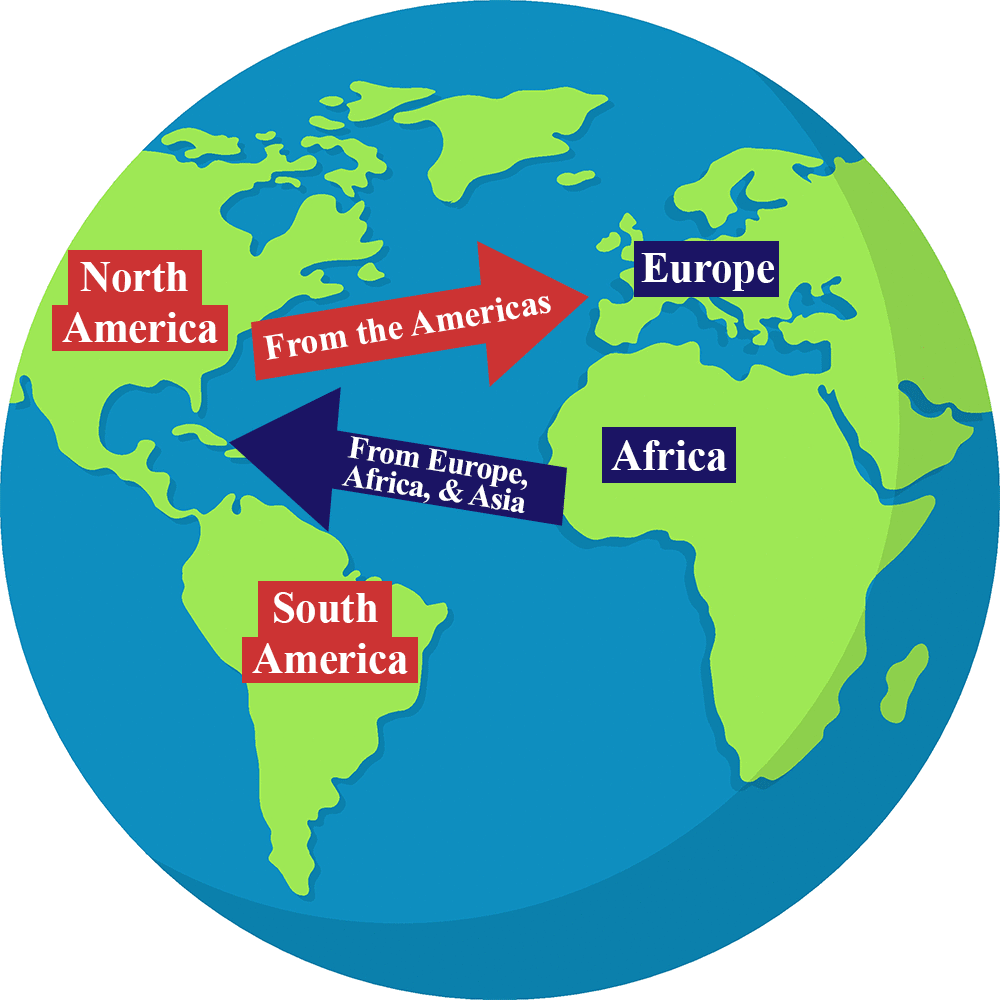The Columbian ⛵Exchange
🌎⛵🌍⛵🌏

🌎⛵🌍⛵🌏
The Columbian exchange, also known as the Columbian interchange, was the widespread transfer of plants, animals, precious metals, commodities, culture, human populations, technology, diseases, and ideas between the New World (the Americas) in the Western Hemisphere, and the Old World (Afro-Eurasia) in the Eastern Hemisphere, in the late 15th and following centuries. It is named after the Italian explorer Christopher Columbus and is related to the European colonization and global trade following his 1492 voyage. Some of the exchanges were purposeful; some were accidental or unintended. Communicable diseases of Old World origin resulted in an 80 to 95 percent reduction in the number of Indigenous peoples of the Americas from the 15th century onwards, most severely in the Caribbean. The cultures of both hemispheres were significantly impacted by the migration of people (both free and enslaved) from the Old World to the New. European colonists and African slaves replaced Indigenous populations across the Americas, to varying degrees. The number of Africans taken to the New World was far greater than the number of Europeans moving to the New World in the first three centuries after Columbus.
The new contacts among the global population resulted in the interchange of a wide variety of crops and livestock, which supported increases in food production and population in the Old World. American crops such as maize, potatoes, tomatoes, tobacco, cassava, sweet potatoes, and chili peppers became important crops around the world. Old World rice, wheat, sugar cane, and livestock, among other crops, became important in the New World. American-produced silver flooded the world and became the standard metal used in coinage, especially in Imperial China.
The term was first used in 1972 by the American historian and professor Alfred W. Crosby in his environmental history book The Columbian Exchange. It was rapidly adopted by other historians and journalists.

🌎⛵🌍⛵🌏

The Columbian Exchange
Crash Course World History #23
In which John Green teaches you about the changes wrought by contact between the Old World and the New. John does this by exploring the totally awesome history book "The Columbian Exchange" by Alfred Crosby, Jr. After Columbus "discovered" the Americas, European conquerors, traders, and settlers brought all manner of changes to the formerly isolated continents. Disease and invasive plant and animal species remade the New World, usually in negative ways. While native people, plants, and animals were being displaced in the Americas, the rest of the world was benefiting from American imports, especially foods like maize, tomatoes, potatoes, pineapple, blueberries, sweet potatoes, and manioc.
Was the Columbian Exchange a net positive?
It's debatable. So debate.


Etymology
In 1972, Alfred W. Crosby, an American historian at the University of Texas at Austin, published the book The Columbian Exchange,[4] and subsequent volumes within the same decade. His primary focus was mapping the biological and cultural transfers that occurred between the Old and New Worlds. He studied the effects of Columbus's voyages between the two – specifically, the global diffusion of crops, seeds, and plants from the New World to the Old, which radically transformed agriculture in both regions. His research made a lasting contribution to the way scholars understand the variety of contemporary ecosystems that arose due to these transfers.[5]The term has become popular among historians and journalists and has since been enhanced with Crosby's later book in three editions, Ecological Imperialism: The Biological Expansion of Europe, 900–1900. Charles C. Mann, in his book 1493 further expands and updates Crosby's original research.
Background
The weight of scientific evidence is that humans first came to the New World from Siberia
thousands of years ago. There is little additional evidence of contacts between the peoples of the Old World and those of the New World, although the literature speculating on pre-Columbian trans-oceanic journeys is extensive. The first inhabitants of the New World brought with them domestic dogs and, possibly, a container, the calabash, both of which persisted in their new home. The medieval explorations, visits, and brief residence of the Norsemen in Greenland, Newfoundland, and Vinland in the late 10th century and 11th century had no known impact on the Americas. Many scientists accept that possible contact between Polynesians and coastal peoples in South America around the year 1200 resulted in
genetic similarities and the adoption by Polynesians of an American crop, the sweet potato. However, it was only with the first voyage of the Italian explorer Christopher Columbus and his crew to the Americas in 1492 that the Columbian exchange began, resulting in major transformations in the cultures and livelihoods of the peoples in both hemispheres.

👇 💻 👇
The Columbian Exchange
Khan Academy
The Columbian Exchange
Khan Academy
Columbus's voyage connected the Americas, Europe, and Africa in a web of exchange that transformed the environments of the Old World and the New World. In this video, Kim Kutz Elliott discusses the impact of the Columbian Exchange.
About Khan Academy: Khan Academy offers practice exercises, instructional videos, and a personalized learning dashboard that empower learners to study at their own pace in and outside of the classroom. We tackle math, science, computer programming, history, art history, economics, and more. Our math missions guide learners from kindergarten to calculus using state-of-the-art, adaptive technology that identifies strengths and learning gaps. We've also partnered with institutions like NASA, The Museum of Modern Art, The California Academy of Sciences, and MIT to offer specialized content.
US
history on Khan Academy: From a mosquito-ridden backwater to the
world's last remaining superpower, the United States of America is a
nation with a rich history and a noble goal: government of the people,
by the people, for the people. Its citizens' struggle to achieve that
goal is a dramatic story stretching over hundreds of years
**
List of Food Plants
Native to the Americas
A number of popular and commercially important food plants are native to the Americas. Some are endemic, meaning they occur naturally only in the Americas and nowhere else, while others occur naturally both in the Americas and on other continents as well.
When complete, the list below will include all food plants native to the Americas (genera marked with a dagger † are endemic), regardless of when or where they were first used as a food source. For a list of food plants and other crops which were only introduced to Old World cultures as a result of the Columbian Exchange touched off by the arrival of Christopher Columbus in 1492, see New World crops.
🌎🌍🌏



🏹 ~*~*~~*~*~~*~*~~*~*~~*~*~~*~*~*~*~~*~*~~*~*~🏹
Indigenous Peoples' Day may refer to:
- International Day of the World's Indigenous Peoples, a United Nations event recognized as a public holiday in various countries observed annually on 9 August
- Indigenous Peoples' Day (United States), a day recognizing Indigenous Peoples in the United States, observed annually on the second Monday in October
- National Indigenous Peoples Day, a day recognizing First Nations in Canada, observed annually on 21 June
- Indigenous Peoples Day (Brazil), annual celebration honoring the indigenous peoples of Brazil, observed annually on April 19

.gif)


No comments:
Post a Comment